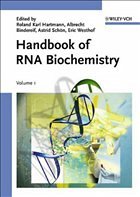
Handbook of RNA Biochemistry
Versandkostenfrei!
Nicht lieferbar
Die Herausgeber dieses Kompendiums stellen Ihnen eine Fülle von Informationen über Laborverfahren zur Untersuchung von RNA zur Verfügung, die sich bislang mühsam in der Originalliteratur suchen mussten. Im Mittelpunkt des Bandes steht der Anwender: Anerkannte Fachleute aus Europa und Nordamerika geben Ihnen wertvolle Tipps für die tägliche Arbeit, insbesondere auch für die Fehlersuche. Das außerordentlich breite Themenspektrum erfasst spezialisierte Verfahren ebenso wie grundlegende biochemische Ansätze zur Isolation, Charakterisierung und funktionellen Analyse von RNA. So planen Sie ...
Die Herausgeber dieses Kompendiums stellen Ihnen eine Fülle von Informationen über Laborverfahren zur Untersuchung von RNA zur Verfügung, die sich bislang mühsam in der Originalliteratur suchen mussten. Im Mittelpunkt des Bandes steht der Anwender: Anerkannte Fachleute aus Europa und Nordamerika geben Ihnen wertvolle Tipps für die tägliche Arbeit, insbesondere auch für die Fehlersuche. Das außerordentlich breite Themenspektrum erfasst spezialisierte Verfahren ebenso wie grundlegende biochemische Ansätze zur Isolation, Charakterisierung und funktionellen Analyse von RNA. So planen Sie Versuche, die wirklich verwertbare Resultate liefern!
----------------------------------------
This all-in-one compendium of current laboratory techniques for the study of RNA brings together numerous novel methods that were hitherto only available through the primary literature. The editors - themselves experienced RNA researchers - have gathered expert authors from the US and Europe for the ultimate in everyday working knowledge. To this end, all the techniques covered are treated with the user in mind, including detailed practical advice and an invaluable "troubleshooting" section.
The broad scope of the book allows the side-by-side treatment of specialized methods with basic biochemical techniques for the isolation, characterization and functional analysis of RNA. All pertinent laboratory methods are presented in detail, including
+ RNA synthesis, modification and ligation
+ Sequence and structure determination of RNA
+ Isolation and purification of ribonucleoproteins
+ RNA crystallization
+ Single molecule studies on RNA
+ Analysis of splice variants
+ RNA imaging in vivo
+ Modeling and prediction of RNA structure
+ RNA microarrays
+ Aptamer libraries and SELEX technology
+ RNA interference
In short, a guide to successful experimentation for molecular biologists, biochemists and biotechnologists and of interest to every researcher experimenting with RNA.
AUS DEM INHALT:
RNA SYNTHESIS
Enyzmatic synthesis, ligation and modification
Chemical synthesis
STRUCTURE DETERMINATION
Sequence determination
Secondary and tertiary structure determination
Footprinting techniques
Identification of interacting proteins and nucleic acids
Nucleotide analog interference mapping
Atomic structure determination
Spectroscopic studies of RNA structure
GENOMICS & BIOINFORMATICS
Phylogenetic analysis
Structure prediction
Molecular dynamics simulation
RNA mining and RNomics
ANALYSIS OF RNA FUNCTION
Isolation and purification of RNA-binding proteins
Genetic analysis of RNA-binding proteins
Three-hybrid analysis to identify RNA-binding proteins
Analysis of mRNA splice variants
Confocal microscopy studies of intracellular localization
In vitro selection of ribozymes and aptamers
RNA INTERFERENCE
Strategies for in vivo RNAi studies
(partial contents)
----------------------------------------
This all-in-one compendium of current laboratory techniques for the study of RNA brings together numerous novel methods that were hitherto only available through the primary literature. The editors - themselves experienced RNA researchers - have gathered expert authors from the US and Europe for the ultimate in everyday working knowledge. To this end, all the techniques covered are treated with the user in mind, including detailed practical advice and an invaluable "troubleshooting" section.
The broad scope of the book allows the side-by-side treatment of specialized methods with basic biochemical techniques for the isolation, characterization and functional analysis of RNA. All pertinent laboratory methods are presented in detail, including
+ RNA synthesis, modification and ligation
+ Sequence and structure determination of RNA
+ Isolation and purification of ribonucleoproteins
+ RNA crystallization
+ Single molecule studies on RNA
+ Analysis of splice variants
+ RNA imaging in vivo
+ Modeling and prediction of RNA structure
+ RNA microarrays
+ Aptamer libraries and SELEX technology
+ RNA interference
In short, a guide to successful experimentation for molecular biologists, biochemists and biotechnologists and of interest to every researcher experimenting with RNA.
AUS DEM INHALT:
RNA SYNTHESIS
Enyzmatic synthesis, ligation and modification
Chemical synthesis
STRUCTURE DETERMINATION
Sequence determination
Secondary and tertiary structure determination
Footprinting techniques
Identification of interacting proteins and nucleic acids
Nucleotide analog interference mapping
Atomic structure determination
Spectroscopic studies of RNA structure
GENOMICS & BIOINFORMATICS
Phylogenetic analysis
Structure prediction
Molecular dynamics simulation
RNA mining and RNomics
ANALYSIS OF RNA FUNCTION
Isolation and purification of RNA-binding proteins
Genetic analysis of RNA-binding proteins
Three-hybrid analysis to identify RNA-binding proteins
Analysis of mRNA splice variants
Confocal microscopy studies of intracellular localization
In vitro selection of ribozymes and aptamers
RNA INTERFERENCE
Strategies for in vivo RNAi studies
(partial contents)



